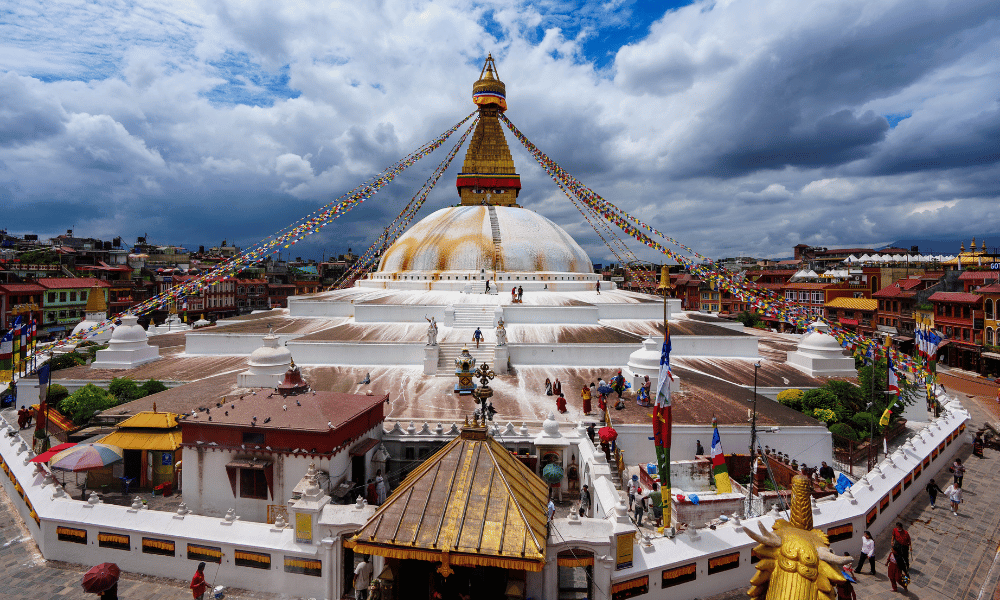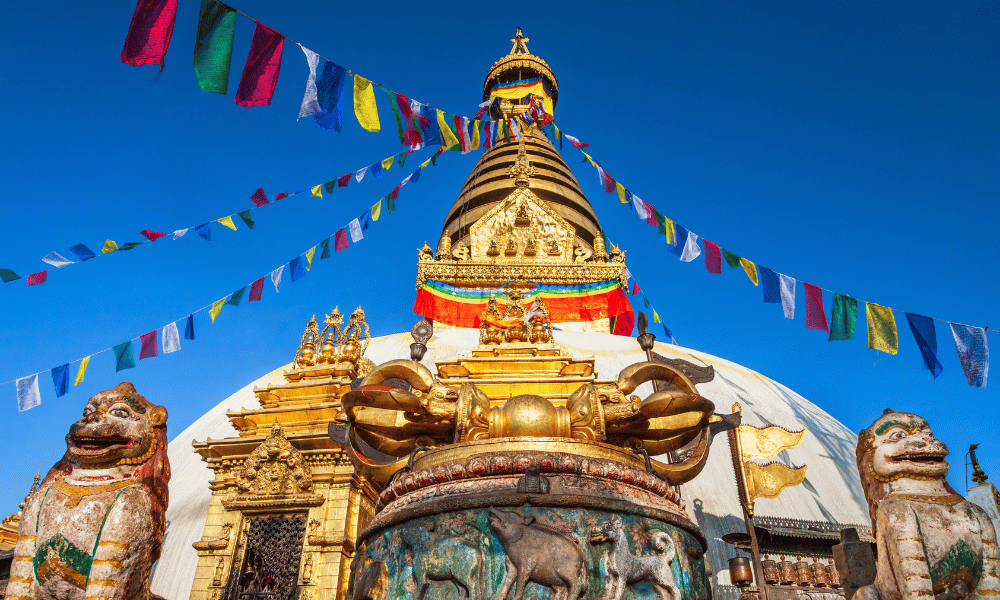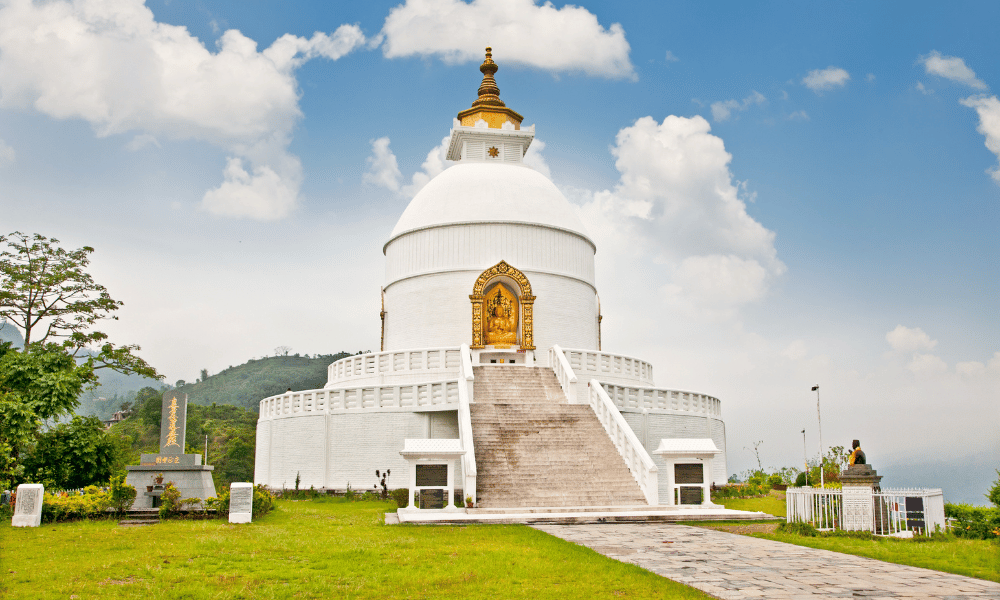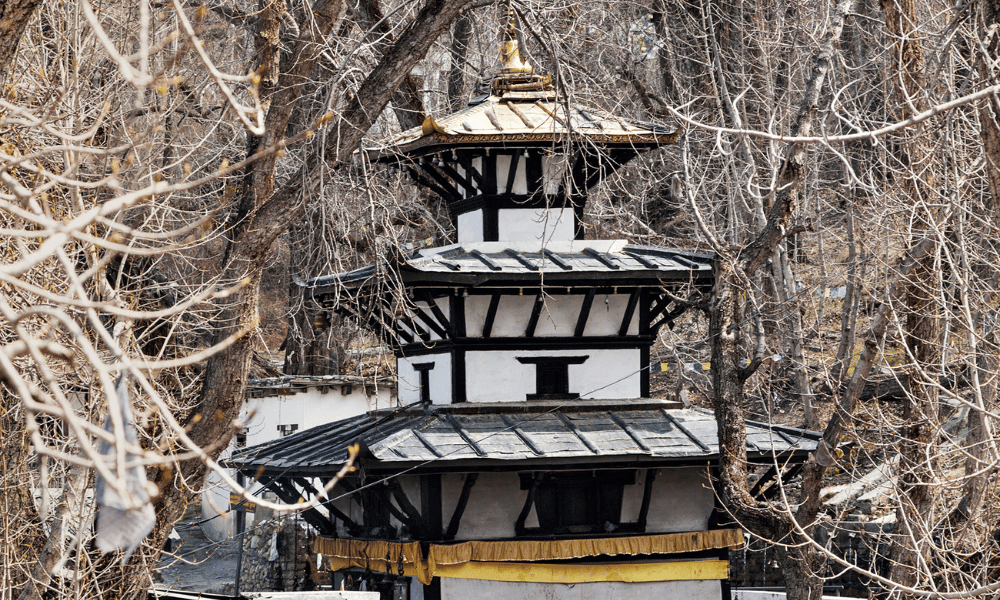Nepal, nestled in the heart of the Himalayas, is more than just a country; it's an experience. Nepal is an amazing array of experiences waiting to be discovered, from the snow-capped peaks of the world's highest mountains, including the mighty Mount Everest, to the rich tapestry of its cultural history.
Nepal has historically been a melting pot of cultures, traditions, and religions. The capital city, Kathmandu, is a living museum of ancient temples, lively markets, and timeless traditions. Beyond urban settings, the peaceful charm of Pokhara's lakes, the wild jungles of Chitwan, and the spiritual aura of Lumbini attract visitors to take part in a variety of activities.
However, there has been a noticeable development in recent years that deserves to be mentioned. A growing number of Indians are choosing Nepal as a vacation destination. The spike is not just a coincidence. The shared history, ease of travel, linguistic similarity, and mutual love for the Himalayas have always lured Indians to this neighboring country. Add to that the friendly relationship between the two countries, and you have a recipe for a fantastic getaway.
Nepal is more than simply another overseas destination for Indians; it's like entering a familiar realm with a twist of surprise. Whether it's the thrill of hiking in the Annapurna range, the spiritual journey to the Pashupatinath temple, or simply enjoying the flavors of Nepalese food, every Indian tourist finds a piece of home in Nepal, as well as something refreshingly new.
In this article, we'll go deeper into the specifics of Nepal holiday packages from India, including why this Himalayan beauty is becoming a popular choice for Indians and how you may make the most of your Nepalese adventure.
Table Of Content
- Why Choose Nepal for Your Next Holiday?
- Visa and Entry Requirements for Indians
- Best Time to Visit Nepal
- Popular Destinations in Nepal
- Trekking Destinations
- Package Highlights and What to Expect
- Budgeting for Your Nepal Trip
- Essential Travel Tips
- Food and Cuisines to Relish
- Shopping in Nepal: What to Buy?
- Making the Most of Your Nepal Visit
- Conclusion
- Frequently Asked Questions (FAQs)
Why Choose Nepal for Your Next Holiday?
Nepal is often called the "Roof of the World," but the country has a lot more to offer than its tall mountains. Here are a few good reasons why you should put it at the top of your list of places to visit:
Proximity to India and Ease of Travel:
-
Close Neighbors: Nepal and India share an open border, which makes it incredibly easy for Indians to travel to Nepal. Whether you're from North India or South India, you're never too far away from this Himalayan paradise.
-
Multiple Modes of Access: Whether you wish to fly or drive, reaching Nepal is hassle-free. Several direct flights connect major Indian cities to Kathmandu. Alternatively, one can embark on a road journey through border towns like Sunauli or Kakarbhitta.
-
No Visa Hassles: A significant advantage for Indian travelers is the visa-free access to Nepal. Just carry a valid photo ID, and you're good to go!
Rich Cultural Heritage and Shared History:
-
Centuries of Ties: India and Nepal share deep-rooted historical and cultural bonds. Be it mythology, religion, or traditions, there's a profound intermingling of cultures.
-
Sacred Sites: Temples like Pashupatinath in Kathmandu or the birthplace of Lord Buddha in Lumbini resonate with Indians, both spiritually and historically.
-
Festivals and Traditions: Festivals like Dashain or Tihar in Nepal have their counterparts in India, making it feel like a home away from home.
The Allure of the Himalayas:
-
Majestic Peaks: Nepal is home to eight of the world's 14 highest peaks, including Mount Everest. Whether you're an avid trekker or someone who loves picturesque landscapes, Nepal's mountains are mesmerizing.
-
Trekking Paradises: From the popular Everest Base Camp trek to the serene trails of the Langtang Valley, there's a trek for every enthusiast.
-
Mountain Villages: Get a chance to immerse yourself in the life of the hardy mountain folk, experience their hospitality, and understand their way of life.
Diversity in Landscapes: From Jungles to High Mountain Peaks:
-
Varied Topography: Nepal's geographical diversity is astounding. In just a few hours, one can travel from the jungles of Terai to the cold deserts of Mustang.
-
Wildlife Expeditions: Beyond the mountains, national parks like Chitwan and Bardia offer a chance to see the majestic Bengal tiger, one-horned rhinos, and a plethora of birds and other wildlife.
-
Lush Valleys and Serene Lakes: The valley of Pokhara, with its pristine lakes, offers a tranquil retreat against the backdrop of the Annapurna range.
In essence, Nepal is an emotion as much as a destination. Its varied landscapes, combined with its cultural wealth and ease of access for Indians, make it a tempting vacation destination. Nepal welcomes you with open arms and the promise of wonderful memories, whether you seek adventure, spirituality, or simply a break from routine.
Visa and Entry Requirements for Indians
In comparison to many other destinations, the process for Indian nationals traveling to Nepal is rather simple. The following is a detailed breakdown of the visa and admission requirements:

Visa on Arrival Benefits for Indian Citizens:
-
Visa Exemption: The visa exclusion for Indian nationals is one of the key benefits of India and Nepal's close connection. Indian citizens do not need a visa to enter or stay in Nepal.
-
Duration of Stay: Even though there is no need for a visa, the length of stay is usually up to the customs officer. But when it comes to tourists, there aren't usually any strict rules.
Necessary Documents and Procedures:
-
Proof of Identity: Indian citizens can enter Nepal by presenting a valid passport or an election card (voter ID) with a photograph. It’s essential to ensure that the ID is valid for at least six more months from the date of entry.
-
Children's Entry: Children under the age of 18 years can travel based on a school identity card with a photograph or a birth certificate, accompanied by their parents.
-
Exiting Nepal: While not mandatory, it's a good practice for Indians to retain hotel invoices, travel documents, or other proof of their stay duration in Nepal. This is just in case any queries arise during exit or re-entry to India.
Special Entry Points for Indian Tourists:
While there are several entry points into Nepal, a few are more commonly used by Indian tourists, both via air and land:
-
By Air: Tribhuvan International Airport in Kathmandu is the primary international gateway by air. Direct flights from cities like Delhi, Mumbai, Kolkata, Bengaluru, and Varanasi frequently ply this route.
-
By Land: Here are some popular land entry points:
-
Sunauli-Bhairahawa: This border is close to Lumbini, the birthplace of Buddha, and is the most used crossing point west of Kathmandu.
-
Kakarbhitta-Siliguri: Situated in the eastern part of Nepal, this is a suitable entry for travelers from West Bengal.
-
Raxaul-Birgunj: Convenient for those coming from Bihar, this border gives direct access to Janakpur in Nepal.
-
Mohana-Dhangadhi: A less crowded entry point suitable for those heading to far western Nepal.
-
Gadda Chauki-Mahendranagar: Located in the far west, it’s ideal for travelers from Uttarakhand.
-
It's important to note that Indians going by road have fewer formalities to go through if they're in their own vehicle than if they're taking public transportation.
Nepal is a great place for Indian tourists to visit because it is easy to get into and doesn't require a lot of paperwork. The relationship between the two countries makes sure that Indians will get a warm welcome in the Himalayas. Before going on a trip, it's always a good idea to check official sources or reputable travel companies to see if any rules have changed.
Best Time to Visit Nepal
Nepal has a variety of climates due to its vast geographical diversity. Understanding these environmental variations is essential for organizing the ideal vacation. Here's an overview of the seasons, the festivals that accompany them, and the best times for outdoor activities.
Understanding Nepal's Seasons:
Winter (December to February)
-
Climate: Cold in the mountains with snow at higher altitudes. The Terai region (southern Nepal) is milder and often foggy in the mornings.
-
Tourist Volume: Lower, making it suitable for travelers who prefer a quieter experience.
Spring (March to May)
-
Climate: Warm with clear skies. The hills are lush with blooming rhododendrons and other wildflowers.
-
Tourist Volume: It's a peak season, especially for trekkers, given the favorable weather conditions.
Monsoon (June to August)
-
Climate: Wet and humid with frequent rain. The landscapes are the greenest during this time.
-
Tourist Volume: Lower because of the rains, which can cause transportation disruptions and landslides in hilly areas.
Autumn (September to November)
-
Climate: Clear skies, crisp air, and great visibility. It’s one of the most favorable times to visit.
-
Tourist Volume: Another peak season, with many trekkers and tourists arriving for the favorable conditions.
Festivals and Cultural Events by Season:
Winter
-
Maghe Sankranti: Celebrated as the winter solstice and the increase of daylight.
-
Shree Panchami: A festival marking the onset of spring and is dedicated to the goddess of education, Saraswati.
Spring
-
Holi: The festival of colors, which is as popular in Nepal as it is in India.
-
Ghode Jatra: The festival of horses celebrated in Kathmandu with various events and horse parades.
Monsoon
-
Ropain Festival: Celebrates the rice planting season with much enthusiasm.
-
Janai Purnima: A sacred thread festival where Brahmins change their Janai (sacred thread).
Autumn
-
Dashain: The most significant Hindu festival in Nepal, similar to Durga Puja in India.
-
Tihar: Equivalent to Diwali in India but celebrated over five days, honoring various animals and finally, the bond between brothers and sisters.
Recommendations for Trekking and Adventure Sports:
Winter
-
Suitable for low-altitude treks.
-
Explore the jungles of Chitwan and Bardia for wildlife safaris.
Spring
-
Ideal for high-altitude treks like Everest Base Camp, Annapurna Circuit, and Langtang Valley.
-
Perfect for white-water rafting as snow melt increases river levels.
Monsoon
-
Not recommended for trekking due to slippery trails and risks of landslides.
-
Upper Mustang and Dolpo regions can be visited as they fall in rain shadows and receive significantly less rain.
Autumn
-
A preferred time for all trekking activities given the clear skies and great visibility.
-
Paragliding in Pokhara is especially popular during this season due to stable thermals and clear skies.
While each season in Nepal has its charm, Spring and Autumn stand out for trekking and outdoor adventures, given the favorable weather conditions. The festivals add a unique cultural flavor to each season, making every visit to Nepal a distinctive experience. Always remember to check local advisories and consult trekking or travel agencies for up-to-date information.
In Depth Read: Best Time to Visit Nepal
Popular Destinations in Nepal
The Kathmandu Valley, which includes the capital city of Kathmandu and its surrounding cities, is Nepal's cultural and historical center. This valley, which is rich in both tangible and intangible legacy, is frequently used as the starting point for many visitors. Let's take a closer look at what it has to offer:
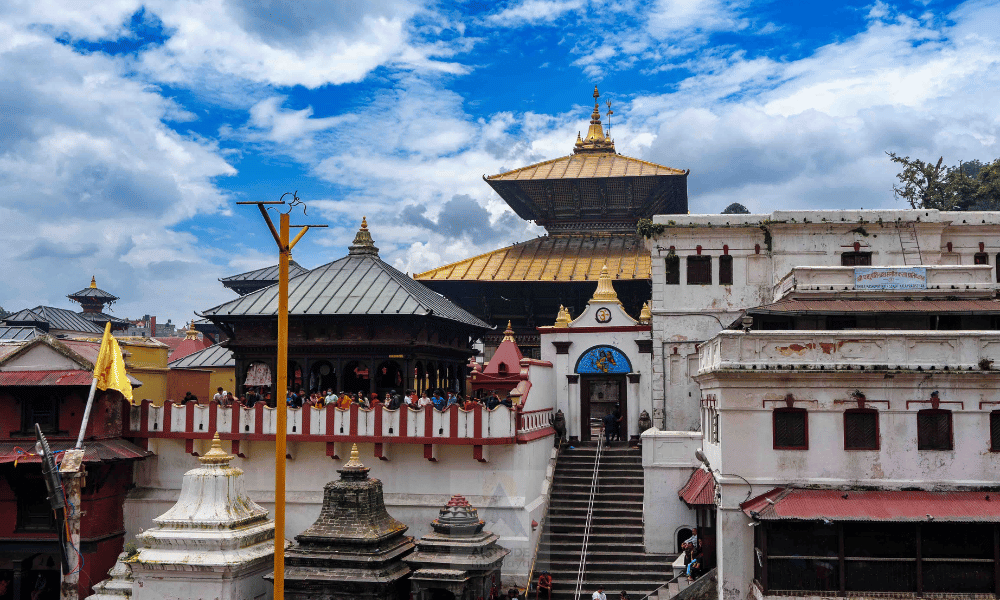
Kathmandu Valley: An Overview
Historical Sites:
Swayambhunath (Monkey Temple):
-
Description: Perched atop a hill, this ancient stupa offers panoramic views of Kathmandu. Dubbed the 'Monkey Temple' because of the numerous monkeys that inhabit the area, Swayambhunath is a blend of Buddhism and Hinduism.
-
Significance: One of the oldest and most iconic structures in Nepal, it symbolizes the country's rich spiritual history. The stupa's eyes, painted on all four sides, represent the all-seeing eyes of Buddha.
-
Tips: Visit during sunrise or sunset for mesmerizing views of the valley.
Pashupatinath Temple:
-
Description: Situated on the banks of the Bagmati River, Pashupatinath is one of Hinduism's most sacred temples dedicated to Lord Shiva.
-
Significance: It's not just a place of worship but also a cremation site. Observing the funeral rituals from a distance provides insights into Hindu customs and beliefs.
-
Tips: Non-Hindus are not allowed inside the main temple but can explore the surrounding areas and observe the ceremonies from across the river.
Patan Durbar Square:
-
Description: Located in the heart of Patan (Lalitpur), this square is an architectural marvel with its palaces, courtyards, and temples.
-
Significance: A testament to Nepal's architectural prowess during the Malla period, the square reflects both the cultural and historical aspects of Nepali life. The Patan Museum, within the palace complex, offers insights into Nepalese art and architecture.
-
Tips: Consider hiring a local guide to truly understand the historical context and stories behind each structure.
Local Experiences and Markets:
Thamel:
-
Description: A bustling neighborhood in Kathmandu known for its narrow alleys lined with shops, restaurants, bars, and hotels.
-
Activities: Shopping for souvenirs, trying local and international cuisines, or just wandering and soaking in the ambiance.
-
What to Buy: Handmade crafts, pashmina shawls, singing bowls, and traditional Nepali wear.
Asan:
-
Description: A traditional market area where you can experience the local hustle and bustle.
-
Activities: A great place to observe daily life, from vendors selling spices and produce to traditional artisans at work.
-
What to Buy: Spices, local produce, and traditional Nepali crafts.
Rickshaw Ride in Old Kathmandu:
-
Description: Traverse the narrow lanes of old Kathmandu on a rickshaw.
-
Experience: It offers a unique vantage point of the city's old quarters, allowing you to observe local life up close.
Cooking Classes:
-
Description: Participate in a Nepali cooking class to learn about the country's culinary traditions.
-
Experience: From momos (dumplings) to dal bhat (lentil soup with rice), immerse yourself in the flavors of NepalThe Kathmandu Valley, with its blend of historical and contemporary structures, provides visitors with a glimpse of Nepal's diverse culture and history. Whether you're a history buff, a spiritual seeker, or just a curious tourist, the valley has something for everyone.
Also Read: Best Time to Visit Kathmandu
Pokhara
Pokhara, Nepal's 'Tourist Capital,' is a paradise for travelers, with spectacular natural beauty and plenty of activities. This pleasant city is a blend of natural treasures and adventurous adventures, situated against the gorgeous background of the Annapurna range.
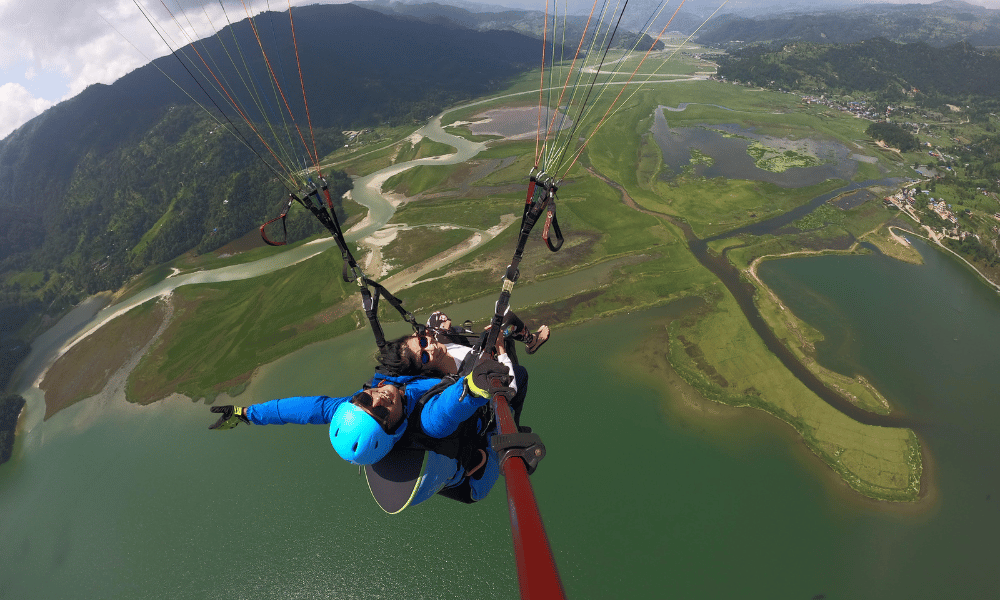
Fewa Lake, Paragliding, and the World Peace Pagoda:
Fewa Lake (Phewa Tal):
-
Description: Nestled amidst the city, Fewa Lake is the heart of Pokhara. Its tranquil waters reflect the mountains and the changing skies, offering a picturesque setting.
-
Activities: Embark on a boat ride, visit the island temple - Tal Barahi, or simply relax by the lakeside, enjoying the ambiance.
-
Tips: Early mornings and evenings are especially magical, with fewer crowds and a mesmerizing play of light on the water.
-
Description: Pokhara is one of the world's top paragliding destinations. Soaring above the valley with panoramic views of the Annapurna range and Fewa Lake is a thrilling experience.
-
Launch Point: Sarangkot, a hill overlooking Pokhara, is the main launch point. The ride offers a unique bird's-eye view of terraced landscapes, traditional villages, and majestic peaks.
-
Tips: Always choose a reputable company with certified pilots for a safe and memorable experience.
World Peace Pagoda (Shanti Stupa):
-
Description: This shining white pagoda is perched atop a hill on the southern shore of Fewa Lake. It's one of the 80 world peace pagodas globally, promoting peace and unity.
-
Significance: It's not only a symbol of peace but also offers panoramic views of the city, lake, and, on a clear day, the encompassing Himalayan range.
-
Tips: Consider hiking up to the pagoda from the lakeside. The trail goes through forests and offers occasional glimpses of the lake and mountains.
Gateway to the Annapurna Region:
Pokhara is often the starting or ending point for numerous treks in the Annapurna region. Here's why:
Strategic Location:
Its proximity to several trailheads makes it an ideal base for trekkers. Many routes in the Annapurna Conservation Area begin or end near Pokhara.
Facilities for Trekkers:
From trekking agencies, gear rentals, and experienced guides to post-trek relaxation spots, Pokhara offers everything a trekker might need.
Popular Treks:
-
Annapurna Base Camp (ABC) Trek: A moderately challenging trek that takes you right into the heart of the Annapurna range.
-
Ghorepani Poon Hill Trek: Known for its sunrise views, this is a shorter trek suitable for beginners or those with limited time.
-
Annapurna Circuit: A longer, more challenging route that circles the Annapurna massif, showcasing the region's diverse landscapes and cultures.
Pokhara combines relaxation and adventure. Pokhara assures that your experiences are as vast as the surrounding mountain ranges, whether you're staring at the reflections on Fewa Lake, soaring in the sky, seeking spiritual comfort at the peace pagoda, or going on a Himalayan trek.
Related Read: Best Time to Visit Pokhara
Chitwan National Park: A Wild Sojourn
Chitwan National Park, located in southern Nepal, is one of the country's most known and biodiversity protected places. It is listed as a UNESCO World Heritage Site and spans a huge area of about 932 square kilometers. Here's what you need to know about Chitwan National Park:
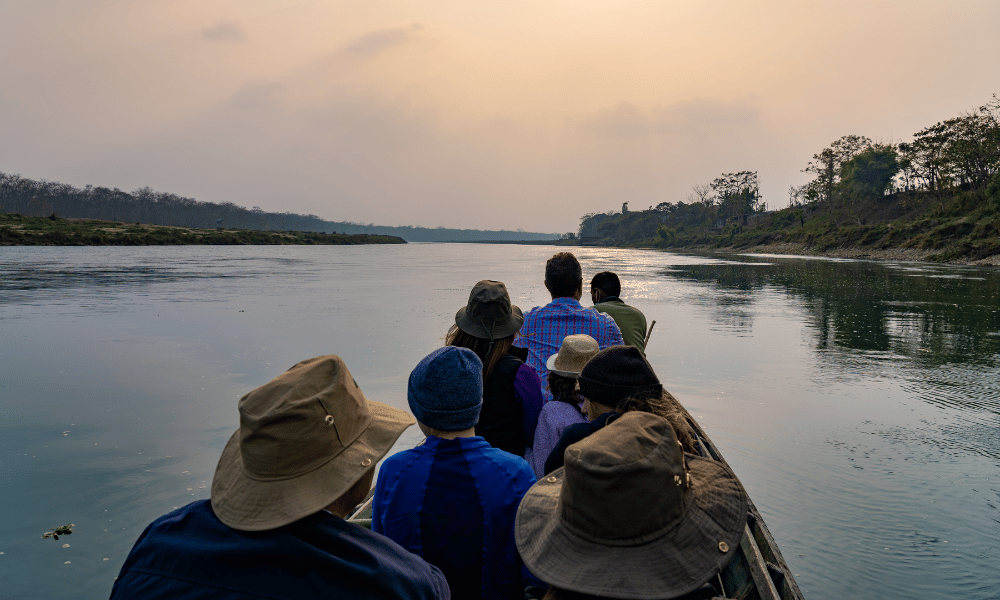
Biodiversity and Conservation:
-
Chitwan National Park is celebrated for its rich biodiversity, featuring a wide array of flora and fauna.
-
It is home to numerous endangered species, including the Bengal tiger, one-horned rhinoceros, Asian elephant, and gharial crocodile.
-
The park plays a crucial role in the conservation of these endangered species and their habitats.
Geographic Diversity:
-
The park's landscape is diverse, ranging from lowland tropical forests and grasslands to the pristine Rapti River that flows through it.
-
The varied terrain offers a habitat for an extensive range of wildlife species.
Wildlife Safari:
-
Chitwan National Park is a popular destination for wildlife enthusiasts and offers thrilling jungle safaris.
-
Visitors can explore the park on elephant-back safaris, jeep safaris, or guided nature walks to spot wildlife in their natural habitats.
Birdwatching Haven:
-
The park is a haven for birdwatchers, with over 500 species of birds, including the Bengal florican, giant hornbill, and many species of waterfowl.
Cultural Experiences:
-
In addition to its natural wonders, Chitwan National Park also offers cultural experiences, allowing visitors to interact with the local Tharu community and learn about their traditions and lifestyle.
Adventure Activities:
-
Beyond wildlife safaris and nature walks, the park offers activities like canoeing, jungle camping, and guided tours to experience its diverse ecosystems up close.
Chitwan National Park is a wonderful destination that combines thrilling wildlife encounters, natural beauty, and cultural experiences, making it a must-see for visitors exploring Nepal's wildness.
Learn More: Chitwan National Park
Lumbini: In the Footsteps of the Buddha
Lumbini, in the Rupandehi District of southern Nepal, is significant culturally and spiritually as the birthplace of Siddhartha Gautama, later known as Lord Buddha. Here's an overview of Lumbini:
Birthplace of Buddha:
-
Lumbini is renowned worldwide as the birthplace of Siddhartha Gautama, the founder of Buddhism, who was born here in 563 BCE.
Spiritual and Religious Importance:
-
Lumbini is a major pilgrimage site for Buddhists from around the globe. It is a place of deep reverence and spiritual reflection.
-
The Maya Devi Temple, located at the site, marks the exact spot where Buddha was born. It is a focal point for pilgrims and tourists alike.
UNESCO World Heritage Site:
-
Lumbini is designated as a UNESCO World Heritage Site, recognizing its cultural and historical significance.
-
The site has undergone extensive preservation and development to accommodate the needs of visitors and to protect its archaeological treasures.
Ashoka Pillar:
-
Emperor Ashoka of the Maurya Dynasty visited Lumbini in the 3rd century BCE and erected a pillar with an inscription that confirmed the birthplace of Buddha. This pillar still stands and is a significant historical artifact.
Lumbini Development Zone:
-
The Lumbini Development Zone encompasses the sacred garden, the Maya Devi Temple, and numerous monasteries and stupas built by Buddhist communities from various countries.
-
It offers visitors a tranquil and spiritually enriching experience as they explore the serene surroundings.
Cultural Exchange:
-
Lumbini serves as a hub for cultural exchange and understanding, with people from diverse backgrounds coming to learn about Buddhism and its principles.
As the birthplace of the Buddha, Lumbini holds a special place in the spiritual and cultural heritage of Nepal and the world. It continues to be a symbol of peace and enlightenment, attracting visitors in search of spiritual comfort and a connection to Buddhist teachings.
Learn More: Lumbini Nepal
Janakpur
Janakpur, located in the southeast of Nepal, is a historically and culturally significant city associated with the legendary figure Sita and her marriage to Lord Rama, as described in the ancient Indian epic Ramayana. Here is a quick overview of Janakpur:

Mythological Importance:
-
Janakpur is often referred to as "Janakpurdham" and is revered as the birthplace of Sita, the central character in the Hindu epic, Ramayana. According to legend, Sita was born here.
Hindu Pilgrimage Destination:
-
The city is a prominent pilgrimage destination for Hindus. The Janaki Mandir, a majestic and ornate temple dedicated to Goddess Sita, is the focal point of religious activities in the region.
Janaki Mandir:
-
The Janaki Mandir is a stunning example of Rajput architecture, with its white marble exterior, intricately carved pillars, and exquisite artwork. It is one of the most important temples in Nepal and attracts devotees and tourists alike.
Cultural Heritage:
-
Janakpur is known for its rich cultural heritage, which includes classical music, dance, and art forms deeply rooted in Hindu traditions. Visitors can witness performances and artwork that reflect the city's cultural vibrancy.
Festivals and Celebrations:
-
The city comes to life during festivals like Vivah Panchami, which commemorates the wedding of Lord Rama and Sita. The celebrations attract pilgrims and tourists who come to witness the grand processions and events.
Janakpur Railway:
-
The Janakpur Railway, also known as the Nepal Railway, connects Janakpur to the Indian border town of Jaynagar. It is an important transportation link for both passengers and cargo.
Art and Craft:
-
The city is famous for its traditional Mithila art, which is characterized by intricate and colorful paintings done by local artists, often depicting mythological themes. Visitors can explore art galleries and purchase Mithila artwork as souvenirs.
Janakpur is not only a religiously significant city, but also a location where history and mythology intersect. It provides a glimpse of Nepal's cultural heritage and remains a place of spiritual significance for people from all aspects of life.
Learn More: Janakpur Nepal
Muktinath Temple
Muktinath, located high in Nepal's Annapurna range, is a revered and breathtaking location with significant spiritual significance for both Hindus and Buddhists. Here's an overview of Muktinath :
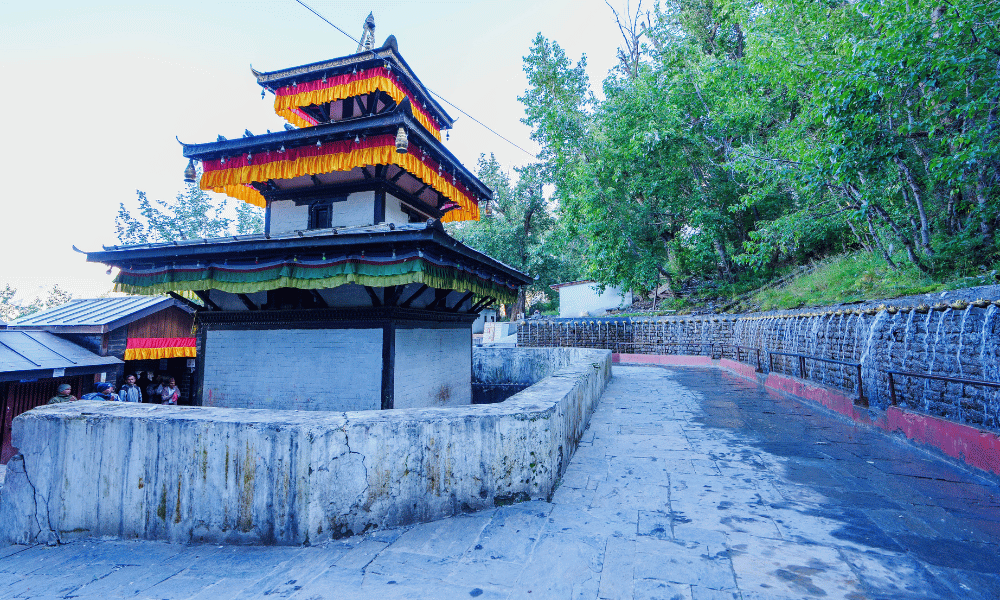
Spiritual Haven:
-
Muktinath is considered one of the holiest places for Hindus. It's believed that a visit to this sacred site helps attain salvation (moksha).
Religious Diversity:
-
Muktinath is unique in that it houses both a Hindu temple and a Buddhist monastery in close proximity, showcasing the coexistence of these two religions.
Natural Beauty:
-
The journey to Muktinath takes you through stunning landscapes, including lush valleys, arid hills, and picturesque villages. The region's beauty is a constant companion on your pilgrimage.
108 Holy Springs:
-
Muktinath is renowned for its 108 holy springs, where freezing water flows from 108 carved cow-head spouts. Pilgrims often take ritual baths in these springs to cleanse their sins.
Mukti Kunda:
-
Mukti Kunda is the larger of the two ponds and is located just in front of the main temple.
-
It consists of two separate ponds with semi-circular stone walls and steps leading down to the water.
-
Pilgrims believe that taking a ritual bath in the holy waters of Mukti Kunda will cleanse them of their sins and help them attain spiritual liberation or "moksha."
Laxmi Kunda:
-
Laxmi Kunda is a small pond located to the left of Mukti Kunda, near the entrance to the temple complex.
-
It is named after the Hindu goddess Laxmi, the deity of wealth and prosperity.
-
Pilgrims believe that bathing in Laxmi Kunda will bring them good fortune and prosperity in addition to spiritual purification.
Ritual Significance:
-
Many pilgrims who visit Muktinath participate in a series of rituals that involve taking a bath in these ponds before entering the temple. The water is icy cold due to the high altitude and originates from the Gandaki River.
-
After the bath, pilgrims proceed to the main temple to offer prayers and pay their respects to Lord Vishnu, the presiding deity of Muktinath.
Mysterious Natural Gas Flames:
-
The temple complex at Muktinath has natural gas flames that perpetually burn near the water springs, creating an otherworldly sight. Locals call these flames "Jwala Mai."
Cultural Exchange:
-
While in Muktinath, you'll have the opportunity to interact with the local Thakali and Tibetan communities, experiencing their unique cultures and traditions.
Adventure Activities:
-
Beyond its religious significance, Muktinath offers adventure seekers opportunities for trekking, hiking, and exploring the stunning landscapes of the Annapurna region.
Scenic Helicopter Rides:
-
For those short on time or unable to trek, helicopter tours are available, providing breathtaking aerial views of the Himalayas and Muktinath.
Weather Considerations:
-
Due to its high altitude, Muktinath experiences cold temperatures, especially in the early morning and evening, so travelers should pack accordingly.
With its blend of spirituality, natural beauty, and adventure, Muktinath offers travelers a unique and enriching experience. Muktinath has something special to offer every traveler who makes the journey to this sacred site, whether they are on a spiritual quest or just looking for the thrill of trekking in the Himalayas.
Learn More: Muktinath Temple
Trekking Destinations
Nepal's diverse landscapes make it a trekker's paradise. From walking in the shadows of the world's highest peaks to traversing lush valleys, Nepal offers an array of trekking experiences.
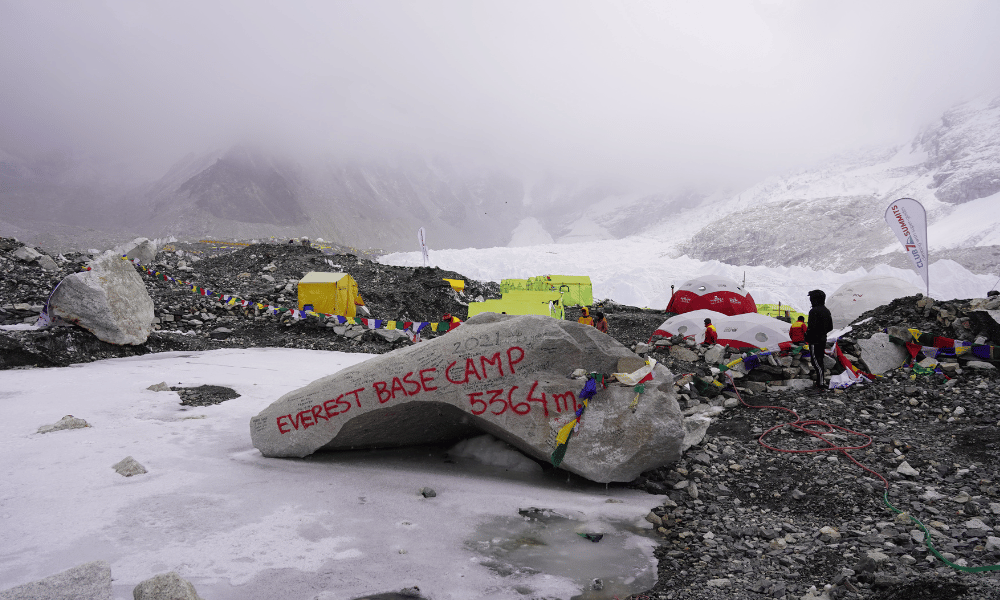
Everest Base Camp:
-
Description: This iconic trek takes adventurers to the base camp of the world's tallest mountain, Mount Everest.
-
Highlights: Stunning views of Everest, Lhotse, Nuptse, and Ama Dablam; Sherpa culture; Tengboche Monastery.
Annapurna Circuit:
-
Description: Circling the Annapurna massif, this trek offers diverse landscapes, from subtropical forests to alpine zones.
-
Highlights: Thorong La Pass (5,416 meters), the deep Kali Gandaki gorge, hot springs, and diverse ethnic cultures.
Langtang Valley:
-
Description: Located north of Kathmandu, this trek is more accessible and less crowded than the previous two.
-
Highlights: Views of Langtang Lirung, Ganesh Himal, and Dorje Lakpa; Tibetan-influenced culture; Kyanjin Gompa.
Other trekking routes, including the Manaslu Circuit, Upper Mustang, and the Gokyo Lakes trip, each provide distinct landscapes and cultural experiences.
Each destination in Nepal tells a different story, from the untamed kingdoms of Chitwan and the spiritual grounds of Lumbini to the towering trails of the Himalayas. Nepal beckons with a variety of promises, whether it's the call of the wild, the draw of ancient teachings, or the uphill battle of mountainous terrains.
Package Highlights and What to Expect
Nepal is a destination of diversity, both in terms of its topography and cultural tapestry. This makes it an ideal destination for various themed tours. When it comes to packaged holidays, here's what you can expect:
Customized Packages:
Adventure Packages:
-
Focus: Engaging in thrilling activities, from mountain expeditions to jungle safaris.
-
Popular Destinations: Everest Base Camp, Annapurna Circuit, Pokhara for paragliding, and Chitwan National Park for safaris.
Spiritual Packages:
-
Focus: Exploring the spiritual heart of Nepal, engaging in retreats, or visiting sacred places.
-
Popular Destinations: Lumbini (the birthplace of Lord Buddha), Pashupatinath Temple in Kathmandu, and various monasteries across the country.
Cultural Packages:
-
Focus: Immersing in Nepal's rich cultural and historical traditions.
-
Popular Destinations: Katu Valley (for its palaces and temples), Patan and Bhaktapur for their Durbar Squares, and various ethnic villages.
Mixed Packages:
-
Focus: A combination of activities to offer a holistic experience of Nepal.
-
Itinerary: Might include a trek, followed by a spiritual retreat, and then a few days exploring the cultural heart of cities.
Average Duration and Itinerary Samples:
Adventure (10-15 days):
-
Days 1-3: Arrival in Kathmandu, acclimatization, and sightseeing.
-
Days 4-12: Trek to the chosen destination (e.g., Everest Base Camp or Annapurna Circuit).
-
Days 13-15: Return to Kathmandu or Pokhara for relaxation and departure.
Spiritual (7-10 days):
-
Days 1-3: Arrival in Kathmandu, visiting temples and monasteries.
-
Days 4-6: Retreat in Lumbini and exploration of the area.
-
Days 7-10: Visiting other sacred sites and departure.
Cultural (7 days):
-
Days 1-2: Exploring Kathmandu's historic sites.
-
Days 3-4: Visiting Bhaktapur and Patan.
-
Days 5-6: Cultural immersion in ethnic villages or attending a local festival.
-
Day 7: Departure.
Mixed (12-15 days):
-
Days 1-5: Trekking in the mountains.
-
Days 6-8: Exploring the cultural sites of Kathmandu or Pokhara.
-
Days 9-11: Retreat or spiritual immersion in Lumbini.
-
Days 12-15: Jungle safari in Chitwan and departure.
Inclusions Typically Offered:
-
Accommodations: Depending on the package, this could range from luxury hotels to teahouses during treks.
-
Transportation: This includes airport transfers, domestic flights (if any), and ground transportation.
-
Meals: Typically, breakfast is included in city stays, while on treks, all meals might be covered.
-
Sightseeing: Entry fees to monuments, parks, or other attractions are generally included.
-
Guides: A knowledgeable local guide, especially valuable during treks or cultural tours, is usually provided.
Nepal holiday packages are designed to ensure travelers experience the best of what the country has to offer. Whether you're soaring in the skies of Pokhara, meditating in Lumbini, or wandering the ancient streets of Kathmandu, these packages promise an unforgettable journey through the heart of the Himalayas. Always ensure you work with reputed travel agencies and read reviews to get the best experience.
Budgeting for Your Nepal Trip
Nepal has options for tourists with all kinds of budgets. Nepal has choices for everyone, whether you want a cheap backpacking trip or a luxurious one. Here's how to plan your trip's budget:
Cost Differences Between Budget, Mid-Range, and Luxury Trips:
Budget Travel:
-
Accommodation: Hostels, budget guesthouses, or basic teahouses during treks. Expect to pay around $5-$15 per night.
-
Food: Local eateries, street food, or self-catered meals can come to around $5-$10 per day.
-
Activities: Focus on free or low-cost activities like sightseeing or shorter treks.
Mid-Range Travel:
-
Accommodation: 3-star hotels or well-rated guesthouses. Prices can range from $30-$60 per night.
-
Food: Dine in mid-range restaurants or cafes. Budget around $15-$30 per day.
-
Activities: Guided tours, standard trekking packages, or cultural experiences might cost between $40-$150 per day, depending on the activity.
Luxury Travel:
-
Accommodation: 4-star to 5-star hotels or luxury lodges, especially in cities. Prices can start from $100 and go up to $500 or more per night.
-
Food: High-end restaurants or hotel dining. Expect to pay upwards of $50 per meal.
-
Activities: Luxury trekking packages, private tours, helicopter rides, or specialized experiences. Costs can vary widely but expect to start from $150 per day.
Hidden Costs to Be Aware Of:
-
Tipping: While not mandatory, it's customary to tip guides, porters, or service staff in hotels and restaurants.
-
Permits: For trekkers, there are permits like TIMS (Trekkers' Information Management System) and conservation area or national park entry fees.
-
Unplanned Transportation: While major transportation might be budgeted, local taxis, rickshaws, or unforeseen transportation can add up.
-
Travel Insurance: Essential, especially if you're trekking or engaging in adventure activities.
-
Emergency Evacuation: In the unlikely event of an emergency during treks, helicopter evacuations can be costly.
Currency Exchange Tips and the Convenience of Using Indian Rupees in Nepal:
-
Currency Exchange: Kathmandu's Tribhuvan International Airport offers currency exchange, but rates might be better in the city. Always compare rates and avoid changing money on the streets.
-
ATMs: They're widely available in cities like Kathmandu and Pokhara. However, it's advisable to carry sufficient cash when heading to remote areas.
-
Using Indian Rupees (INR): While INR is accepted in many places in Nepal, it's essential to note that denominations above INR 100 may not be widely accepted. It's always a good idea to have some Nepalese Rupees (NPR) for convenience.
-
Card Payments: Major hotels, restaurants, and shops in cities accept credit and debit cards, but it's recommended to ask beforehand.
Nepal offers a range of experiences for different budgets. Planning ahead, being aware of potential hidden costs, and understanding the currency scenario can help ensure a smooth financial experience during your trip.
Essential Travel Tips
Nepal, with its rich blend of cultures, religions, and terrains, requires thoughtful preparation. Here are some essential travel tips to ensure a respectful and enjoyable trip:

Cultural Etiquettes and Respect for Religious Sites:
-
Dress Modestly: Especially when visiting temples, monasteries, or other religious sites. For women, it's advisable to wear long skirts or trousers and cover shoulders. Men should avoid wearing sleeveless shirts.
-
Shoes Off: Before entering a religious site or someone's home, it's customary to remove your shoes.
-
Circumambulation: When walking around religious monuments like stupas or temples, always walk clockwise.
-
Public Affection: Displaying affection openly, such as kissing, might be frowned upon, especially in rural areas.
-
Greetings: The traditional greeting is "Namaste," accompanied by pressing your palms together in a prayer-like gesture.
Health Precautions and Recommended Vaccinations:
-
Water: Stick to bottled water and avoid tap water to prevent waterborne diseases.
-
Food: Eat at reputable places. Ensure hot meals are freshly cooked and avoid raw salads or ice.
-
Altitude Sickness: If trekking in high-altitude areas, be mindful of altitude sickness. Ascend slowly and stay hydrated.
-
Vaccinations: Recommended vaccines include Hepatitis A, Typhoid, and Tetanus. Depending on your activities and destinations, you might consider Hepatitis B, Japanese Encephalitis, Rabies, and Yellow Fever vaccines. Consult with a travel clinic or doctor for personalized advice.
-
Travel Insurance: Ensure you have insurance that covers high-altitude trekking if you plan to hike.
Local SIM Cards, Connectivity, and WiFi Availability:
-
SIM Cards: Local SIM cards are readily available from providers like NTC (Nepal Telecom) and Ncell. They're affordable and can be bought at the airport or local shops.
-
Connectivity: Urban areas, including Kathmandu and Pokhara, have good mobile connectivity. Remote areas, especially during treks, might have limited or no coverage.
-
WiFi: Most hotels, restaurants, and cafes in cities offer free WiFi. Some teahouses on popular trekking routes also provide WiFi for a fee.
Packing Essentials Based on Destinations and Activities:
Trekking:
-
Layered clothing for varying temperatures.
-
Waterproof jacket and pants.
-
Trekking boots, woolen socks, and hats.
-
Sunglasses with UV protection.
-
Trekking poles, sleeping bag, and a first-aid kit.
City Visits:
-
Comfortable walking shoes.
-
Light cotton clothing for summer and warm clothes for winter.
-
A daypack for carrying essentials.
Jungle Safaris (e.g., Chitwan):
-
Neutral-colored clothing.
-
Insect repellent and binoculars.
-
Hat and sunglasses.
Spiritual or Cultural Exploration:
-
Modest clothing covering shoulders and knees.
-
A small scarf can be handy for women.
General:
-
Universal power adapter.
-
Personal medications and a basic first-aid kit.
-
Hand sanitizers and wet wipes.
Remember that these tips are a good starting point, but you should always do additional research based on your plans. Nepal is a welcoming country, and a little mindfulness may enhance your trip and guarantee lasting memories.
Food and Cuisines to Relish
Nepalese cuisine reflects the country's rich cultural diversity and geographic variation. With an amalgamation of flavors from its neighboring countries and its own indigenous communities, the food in Nepal is a delightful experience for the palate.
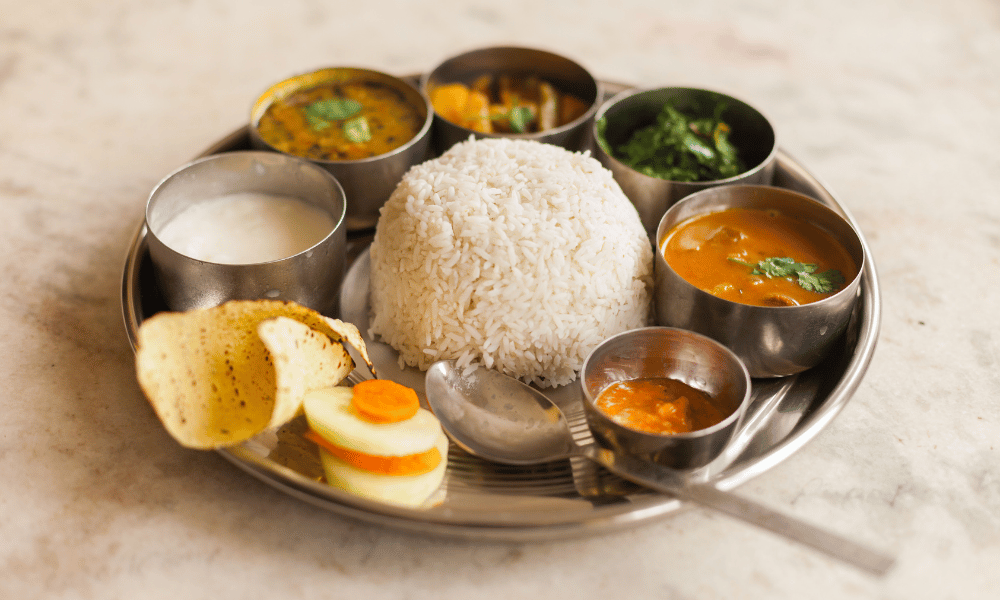
Nepalese Delicacies:
Momo:
-
Description: Dumplings filled with either meat or vegetables.
-
Variations: Steamed, fried, or in a spicy sauce called "Jhol momo".
-
Options: Vegetarian (usually filled with finely chopped vegetables) and Non-Vegetarian (commonly chicken or buffalo meat).
Dal Bhat:
-
Description: A staple meal consisting of lentil soup (dal) and rice (bhat). It's usually accompanied by vegetable curries, chutney, and might also include meat curries or fried fish.
-
Options: Generally vegetarian, but meat can be added.
Thukpa:
-
Description: A noodle soup that originated from Tibet but is popular in Nepal. It contains meat or vegetables, flavored with green chili sauce.
-
Options: Vegetarian and non-vegetarian, usually chicken or mutton.
Sel Roti:
-
Description: A traditional homemade, sweet, ring-shaped rice bread/doughnut.
-
Option: Primarily vegetarian.
Chatamari:
-
Description: Sometimes referred to as 'Nepali Pizza', it's a kind of Rice Crepe which is a traditional specialty of the Newars of the Kathmandu Valley.
-
Options: Vegetarian toppings or with meat, commonly chicken or buffalo.
Beverages:
Masala Tea (Chiya):
-
Description: A spiced tea made with milk, tea leaves, sugar, and spices like cardamom, ginger, and cloves.
-
Option: Vegetarian.
Tongba (Hot Millet Beer):
-
Description: A traditional and indigenous drink of the Limbu people of eastern Nepal. It’s a millet-based alcoholic beverage where hot water is added to fermented millet to produce a mild beer.
Raksi:
-
Description: A traditional distilled alcoholic beverage in Nepal and Tibet. It's often made from millet or rice.
Chhang:
-
Description: A type of rice beer consumed widely in the hilly regions.
Tips for Vegetarians:
While there are many meat dishes available in Nepal, vegans should not be concerned. Because of the country's Hindu and Buddhist influences, many Nepalese recipes are vegetarian by default. Always specify what you want, as many restaurants will comply and may prepare dishes without the meat if requested.
Dining in Nepal is about the environment and hospitality as much as it is about the flavors. Whether you're enjoying a hearty plate of Dal Bhat in a highland teahouse or sipping spicy masala tea in a crowded Kathmandu bazaar, Nepal's culinary delights will leave an everlasting impact on your trip experiences.
Related Read: Pure Veg Restaurants In And Pokhara
Shopping in Nepal: What to Buy?
Nepal, with its rich cultural heritage and artisan communities, offers a plethora of unique items for shoppers. Whether it's hand-woven textiles or intricately crafted artifacts, there's a piece of Nepal waiting to be taken home by every visitor.
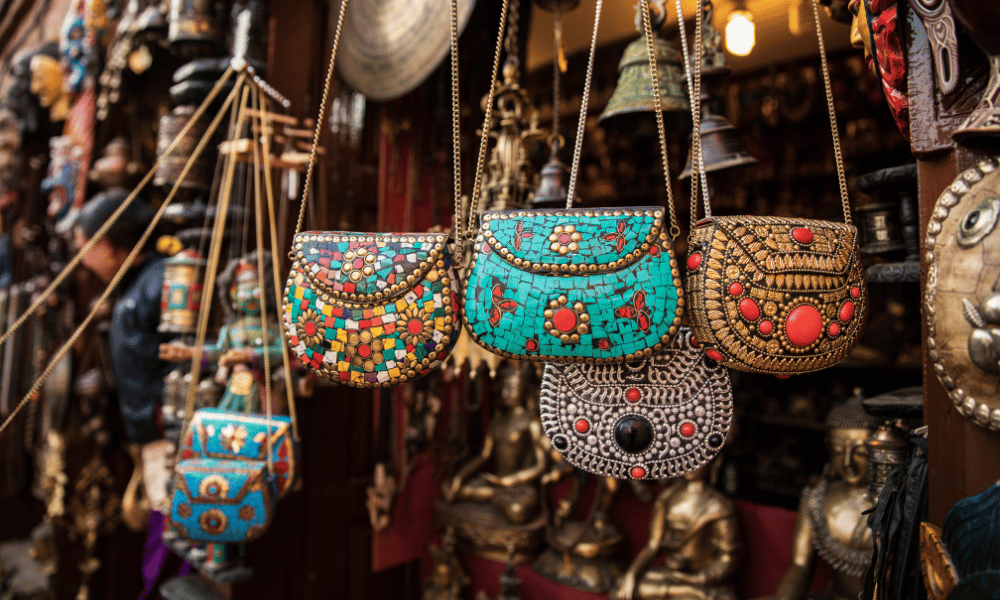
What to Buy:
Handicrafts:
-
Description: Skillfully made wood carvings, traditional masks, pottery, and sculptures.
-
Special Mention: Thangka paintings, which are detailed hand-painted artworks often depicting Buddhist deities.
Pashmina Shawls:
-
Description: Luxurious shawls made from the wool of the Himalayan goat. They're incredibly soft, warm, and make for an elegant accessory.
Singing Bowls:
-
Description: Used for meditation and healing. When played, they produce resonant sounds that are believed to help in relaxation and chakra balancing.
Kukri (Khukuri):
-
Description: The traditional knife of the Gurkhas, with its distinctive inwardly curved blade. It's symbolic of Nepalese culture and valor.
Beaded Jewelry:
-
Description: Colorful necklaces, bracelets, and earrings made using semi-precious stones and beads.
Tea:
-
Description: Nepal produces high-quality teas, especially from the Ilam region. Varieties include green, white, oolong, and black tea.
Best Places to Shop:
Kathmandu:
-
Thamel: The most popular tourist hub, with numerous shops selling everything from handicrafts to pashminas and trekking gear.
-
Patan: Known for its fine metalwork, especially statues and singing bowls.
-
Bhaktapur: A great place to buy pottery and wood carvings.
-
Boudhanath and Swayambhunath: These religious sites have surrounding stalls selling religious artifacts, thangka paintings, and more.
Pokhara:
-
Lakeside: The main shopping and dining area in Pokhara. It's dotted with shops selling handicrafts, clothing, and trekking equipment.
Bargaining Culture and Tips:
-
Expect to Bargain: Bargaining is commonplace in Nepal, especially in markets and tourist areas.
-
Start Lower: Start by offering a price that's about 50-60% of the initial quoted price.
-
Be Respectful: Bargaining should be a friendly interaction. It's okay to negotiate, but always be respectful and avoid being too aggressive.
-
Know When to Stop: If the seller declines your offer and doesn't budge after several attempts, it's either time to accept their last price or gracefully walk away.
-
Bulk Buying: If you're buying multiple items, ask for a discount. Sellers are often more willing to give a better deal for bulk purchases.
-
Local Guidance: If possible, shop with a local or ask your guide for approximate prices. This will give you a baseline for negotiation.
Shopping in Nepal is more than just buying souvenirs; it is also about experiencing the country's unique craft culture. Talking to local sellers, learning about the craftsmanship, and taking a piece of Nepal's culture home is an experience in and of itself.
Making the Most of Your Nepal Visit
Nepal, with its sprawling landscapes and rich tapestry of cultures, offers more than just picturesque sights. To truly soak in the essence of the country, it's essential to immerse oneself in its traditions, interact with the locals, and travel responsibly.
Interacting with Locals and Understanding Their Way of Life:
-
Home Stays: Opt for a home stay instead of a hotel in some parts of your journey. It provides an authentic experience, allowing you to observe the daily life of locals and often participate in their routines.
-
Local Eateries: Skip the tourist restaurants and head to where the locals dine. It's not just about tasting authentic cuisine but also about mingling with the local populace.
-
Language: Learning a few basic Nepali phrases can go a long way. A simple "Namaste" (Hello) or "Dhanyabad" (Thank you) can warm hearts and open doors.
Being Responsible Tourists: Eco-tourism and Sustainable Travel:
-
Pack in, Pack Out: Especially during treks, ensure that you carry back all non-biodegradable waste with you.
-
Use Refillable Bottles: Nepal has many safe water refill stations, particularly in tourist areas, to reduce the use of plastic bottles.
-
Support Local Artisans: Buy handicrafts and products directly from the artisans or from fair-trade shops to ensure the money goes to the craftspeople.
-
Eco-lodges and Green Stays: Opt for accommodations that practice sustainability. Eco-lodges are becoming increasingly popular, especially in trekking regions.
-
Limit Energy Consumption: While in remote areas, be mindful of electricity consumption, as many places rely on solar power or generators.
Participating in Local Festivals and Traditions:
-
Tihar (Festival of Lights): Houses and public spaces are adorned with oil lamps and candles. It's similar to Diwali in India but with its own set of traditions, like honoring animals.
-
Holi: The festival of colors celebrates the arrival of spring. Locals and tourists alike smear each other with colored powders.
-
Teej: A significant festival for Hindu women, it involves fasting and dancing. Women wear red and sing traditional songs.
-
Dashain: The most significant Hindu festival in Nepal, it celebrates the victory of good over evil. Families come together, honor their elders, receive blessings, and exchange gifts.
-
Attend a Traditional Wedding: If you're invited to a Nepali wedding, it's a unique opportunity to witness local customs and traditions.
Nepal is more than just a place to visit; it's a way of life. By digging deeper into its cultural intricacies, practicing sustainable travel, and engaging with the locals, you may truly appreciate the soul of the country. It's the people you meet, the things you learn, and the moments you make that make a trip a trip of a lifetime.
Related Read: Nepal Festival Calendar
Conclusion
Nepal, which is often called "the roof of the world," is more than just its tall mountains and the beauty of the Himalayas. It is a blend of traditions, cultures, and natural wonders that weaves together a masterpiece that is both diverse and lively. Every step in this country tells a story, from the busy streets of Kathmandu, which are full of history and art, to the serene trails that lead to the heart of the world's tallest mountains.
But more than the beautiful scenery and historic structures, this country is truly defined by the generosity of its people. Their smiles, stories, and practices that have been around for hundreds of years invite visitors to do more than just look around. Nepal shares a piece of its soul with every guest, whether it's through a shared meal, a lively dance, or a quiet moment among the mighty mountains.
So, if you're looking for an experience rather than a destination, if you want to be a traveler rather than a tourist, let the winds of the Himalayas guide you. Nepal is a beautiful country with a rich history and a strong spirit. Dig deep into its core, as you might find a reflection of yourself.
Come see Nepal, where every heartbeat echoes with ancient traditions and every landscape calls out with beauty that can't be found anywhere else.
Frequently Asked Questions (FAQs)
Do Indian citizens require a visa to travel to Nepal?
No, Indian citizens do not require a visa to enter Nepal. They can enter with a valid passport or even an election card.
What's the currency exchange rate between Indian Rupees (INR) and Nepalese Rupees (NPR)?
The exchange rate varies, but as of my last update, 1 INR was roughly equivalent to 1.6 NPR. It's advisable to check current rates before travel.
Is it safe for solo travelers, especially women, to travel to Nepal?
Generally, Nepal is considered safe for solo travelers, including women. However, like any destination, it's essential to take standard safety precautions.
How do I reach Nepal from India?
Nepal can be accessed by air, with the most common entry point being Kathmandu's Tribhuvan International Airport. There are also several land entry points along the India-Nepal border.
Are vegetarian food options readily available in Nepal?
Yes, Nepal offers a plethora of vegetarian dishes, owing to its Hindu and Buddhist influences.
What's the best time to visit Nepal?
The ideal time for trekking is during the spring (March to May) and autumn (September to November) months. For cultural tours, Nepal can be visited year-round, but monsoon season (June to August) can be wet.
How is the internet connectivity in Nepal?
Cities like Kathmandu and Pokhara offer good internet connectivity, with many hotels, cafes, and restaurants providing free Wi-Fi. However, in remote areas or during treks, connectivity can be limited.
Is English widely spoken in Nepal?
In tourist areas, English is commonly understood and spoken. However, in rural or remote regions, Nepali or local dialects predominate.
Are Indian Rupees accepted in Nepal?
Indian Rupees are accepted in many places in Nepal, but denominations above INR 100 might not be widely accepted. It's recommended to carry some Nepalese Rupees for convenience.
What kind of power sockets are used in Nepal?
Nepal uses Type C, D, and M sockets. The standard voltage is 230V. It's a good idea to carry a universal adapter.
Can I use my mobile phone in Nepal?
Yes, upon arrival, you can purchase a local SIM card from providers like NTC (Nepal Telecom) or Ncell for local calls and data.
What type of clothing should I pack for Nepal?
It depends on the time of visit and activities. Layered clothing is recommended for treks. For cultural visits, modest clothing respecting local customs is advisable.


